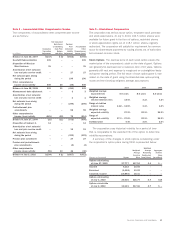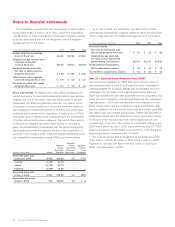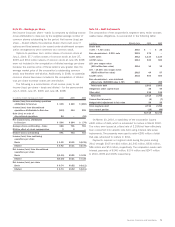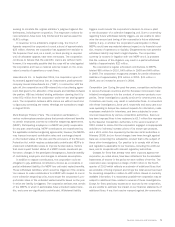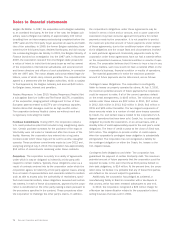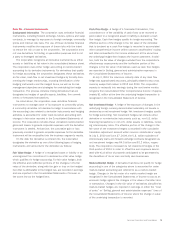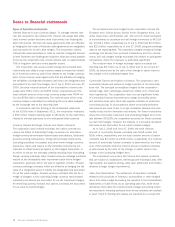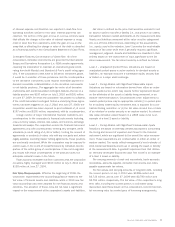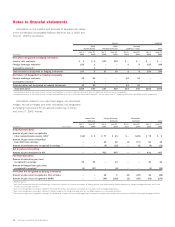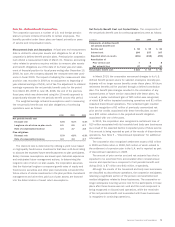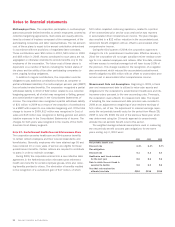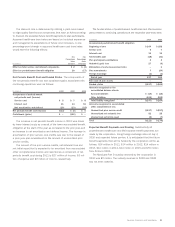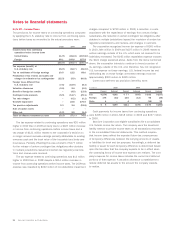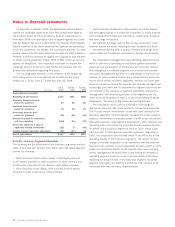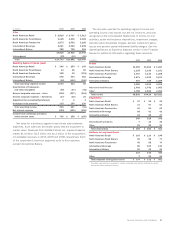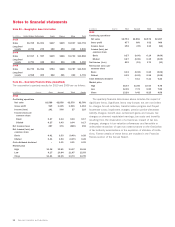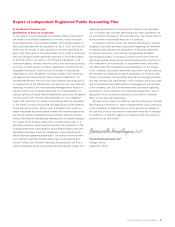Sara Lee 2010 Annual Report Download - page 81
Download and view the complete annual report
Please find page 81 of the 2010 Sara Lee annual report below. You can navigate through the pages in the report by either clicking on the pages listed below, or by using the keyword search tool below to find specific information within the annual report.
Sara Lee Corporation and Subsidiaries 79
Note 16 – Defined Benefit Pension Plans
The corporation sponsors a number of U.S. and foreign pension
plans to provide retirement benefits to certain employees. The
benefits provided under these plans are based primarily on years
of service and compensation levels.
Measurement Date and Assumptions A fiscal year end measurement
date is utilized to value plan assets and obligations for all of the
corporation’s defined benefit pension plans. Previously the corporation
had utilized a measurement date of March 31. However, accounting
rules related to pensions requires entities to measure plan assets
and benefit obligations as of the date of its fiscal year-end state-
ment of financial position for fiscal years ending after December 15,
2008. As such, the company adopted the measurement date provi-
sions in fiscal 2009. The impact of adopting the measurement date
provision was recorded in 2009 as an adjustment to beginning of
year retained earnings of $(15), net of tax. The adjustment to retained
earnings represents the net periodic benefit costs for the period
from March 28, 2008 to June 28, 2008, the end of the previous
fiscal year, which was determined using the 15-month approach to
proportionally allocate the net periodic benefit cost to this period.
The weighted average actuarial assumptions used in measuring
the net periodic benefit cost and plan obligations of continuing
operations were as follows:
2010 2009 2008
Net periodic benefit cost
Discount rate 6.5% 6.3% 5.4%
Long-term rate of return on plan assets 6.9 6.9 6.7
Rate of compensation increase 3.4 3.7 3.8
Plan obligations
Discount rate 5.3% 6.5% 6.3%
Rate of compensation increase 3.3 3.4 3.7
The discount rate is determined by utilizing a yield curve based
on high-quality fixed-income investments that have a AA bond rating
to discount the expected future benefit payments to plan participants.
Salary increase assumptions are based upon historical experience
and anticipated future management actions. In determining the
long-term rate of return on plan assets, the corporation assumes
that the historical long-term compound growth rates of equity and
fixed-income securities and other plan investments will predict the
future returns of similar investments in the plan portfolio. Investment
management and other fees paid out of plan assets are factored
into the determination of asset return assumptions.
Net Periodic Benefit Cost and Funded Status The components of
the net periodic benefit cost for continuing operations were as follows:
In millions 2010 2009 2008
Components of defined benefit
net periodic benefit cost
Service cost $÷«58 $÷«59 $÷«81
Interest cost 264 257 267
Expected return on assets (261) (268) (293)
Amortization of
Prior service cost 788
Net actuarial loss 47 11 34
Net periodic benefit cost $«115 $÷«67 $÷«97
In March 2010, the corporation announced changes to its U.S.
defined benefit pension plans for salaried employees whereby par-
ticipants will no longer accrue benefits under these plans. All future
retirement benefits will be provided through a defined contribution
plan. The benefit plan changes resulted in the elimination of any
expected years of future service associated with these plans. As
a result, a pretax curtailment gain of $25 million was recognized,
of which $24 million impacted continuing operations and $1 million
impacted discontinued operations. The curtailment gain resulted
from the recognition of $3 million of previously unamortized net
prior service credits associated with these benefit plans as well
as a $22 million reduction in the projected benefit obligation
associated with one of the plans.
In 2010, the corporation also recognized a curtailment loss of
$10 million associated with its household and body care businesses
as a result of the expected decline in expected years of future service.
This amount is being reported as part of the results of discontinued
operations. See Note 5 – “Discontinued Operations” for additional
information.
The corporation also recognized settlement losses of $2 million
in 2009 and $16 million in 2008, $15 million of which related to
the settlement of a pension plan in the U.K. and is reported as part
of discontinued operations in 2008.
The amount of prior service cost and net actuarial loss that is
expected to be amortized from accumulated other comprehensive
income and reported as a component of net periodic benefit cost
during 2011 is $7 million and $43 million, respectively.
Although the results of the household and body care businesses
are classified as discontinued operations, the corporation anticipates
retaining a significant portion of the pension and postretirement
medical obligations related to these businesses. The corporation no
longer anticipates incurring service cost for the participants in these
plans after these businesses are sold and this cost component is
being recognized in discontinued operations, while the remainder
of the net periodic benefit cost associated with these businesses
is recognized in continuing operations.


